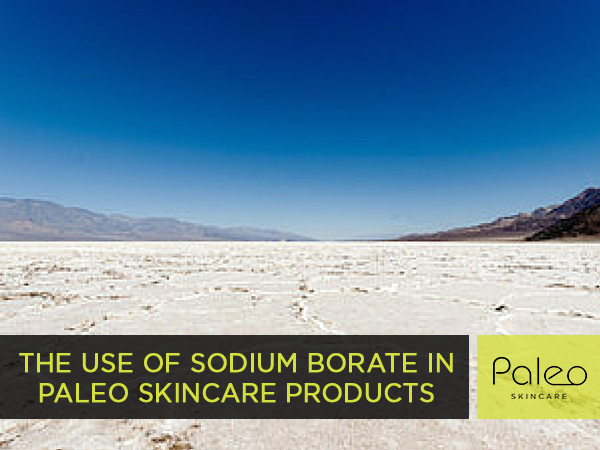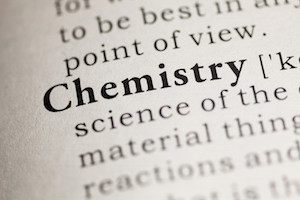The Use of Sodium Borate in Paleo Skincare Products

Is Sodium Borate Safe?
Absolutely.
Sodium Borate is the same as Borax, but not to be confused with Boric Acid (many documents refer to these interchangeably, but they are definitely not the same ingredient). However, as you may have some concerns here, we’d like to explain what this is and why we’ve chosen to use it in our products.
A lot of the anti-borax literature concentrates on the emotive statement that this ingredient is found in cockroach killers. Although this is true, concentration and ingredient combinations are relevant. Ingestion of high concentrations of borax are most certainly toxic, but this is far removed from the quantities and applications used in our skincare products. An analogy would be that salt, although essential for life, can also be toxic if consumed in concentrated amounts. As a direct comparison, the median lethal dose in rats for common salt is; 3.0 g/kg (body weight), and for Boron is 2.66g/kg (Reference Wiki) and they have about the same level of acute toxicity. Borax is categorized as not acutely toxic and non-carcinogenic (1), and it is readily excreted in urine. Hence even with prolonged exposure, Borax does not accumulate in the body.
What is Sodium Borate - The Technical Side
Material Safety Data Sheets list borax as a health hazard of level 1, which is the same as baking soda or common table salt. Skin effects of concentrated borax are similar to prolonged exposure to baking soda, or salt, and are most likely caused by the abrasive nature of the crystals and the alkaline pH of around 9. These irritant properties are no longer applicable once borax is incorporated into a cream or soap formulation because of the extremely diluted nature of the Sodium Borate, and the fact that the abrasive crystals are uniformly dissolved in the base cream and therefore no longer present.
Sodium Borate (or borax) is an important boron compound, a mineral, and a salt of boric acid. It is a white powder, consisting of soft colourless crystals that are easily dissolved in water, with a chemical structure of Na2B4O7. This means that one molecule of borax is made up of 2 molecules of sodium (the same sodium that is found in sodium chloride, or common table salt), 4 molecules of Boron, and seven molecules of oxygen.
Boron is an essential nutrient for plants and maybe humans too.
We all know what sodium and oxygen are, but what exactly is boron? It is defined as an essential nutrient for plants, but until recently has not been generally recognised as being essential for human beings. Recent research indicates that boron may play pivotal roles in the metabolism of calcium, magnesium and vitamin D in bone health and arthritis, and also contributes to digestion and hormonal systems, including reproductive glands and the thyroid (2) (3).
Recent research also seems to indicate that many people (in America) have suboptimal dietary boron, especially where food sources are grown in boron deficient soils (4).
This is also applicable in Australia because Australian soils are generally quite deficient in boron. A number of readily available mineral supplements now contain borax in order to provide the bioavailable boron that the body needs.
It all comes from Mother Nature
That is the technical bit, but what is Sodium Borate? Most of the world’s industrial borax is mined from dried salt lakes from either Turkey or California. There is no synthetic borax: it all comes from Mother Nature and ancient evaporative lakes. The mined mineral is simply dehydrated to create the chemical that is used in industry and manufacturing.
In our research (as with any research) we found many different opinions about the use of Sodium Borate in cosmetics and skincare. Unfortunately, some reviews seem to suggest that almost anything is dangerous to put on your skin. If you are at all familiar with Paleo Skincare, you’ll know that we do not condone putting just 'anything' on your skin.
We believe that Sodium Borate is not dangerous in the amounts that we use. It has GRAS status in cosmetics at levels up to 5%, and we use it in levels less than or equal to 1% The amount of actual boron in our products is less than 0.2%. Sodium Borate has very important function in our products as it prevents and distorts bacterial growth and therefore helps to ensure that the product won’t spoil. A spoiled product would be far more dangerous for you to use.
Sodium borate also has many more essential functions in our formulations than just helping to inhibit the bad bugs and moulds. It is also unsurpassed as an emulsifying agent, especially when combined with bees’ wax, acts as a water softener, a pH buffer, and a gentle cleanser and antiseptic.
We would be negligent as a skincare manufacturer to sell products which degraded rapidly or were easily contaminated with microbes or mould. We carefully consider all the ingredients that are included in our products to ensure that they are the safest ingredients available to use. Nevertheless, because of the minimal use of preservatives, our products do have a limited shelf life once they have been opened.
We feel you have far more cause for concern regarding the use of formaldehyde, petrochemicals, phthalates, manufactured fragrances and preservative chemicals and the many other nasty things you can find lurking in your cosmetics and cleansers at home.
Due to labeling loopholes which mean that ingredients found in very low concentrations do not have to be listed many manufacturers do not list all the ingredients their products contain. We list all our ingredients and have researched them thoroughly to be certain that all our ingredients are safe for your skin.
References
- www.rosemill.com/v/html/msds/borax%20Fisher.pdf
- www.ncbi.nlm.nih.gov/pmc/articles/PMC1566632/pdf/envhper00403-0067.pdf
- http://www.ithyroid.com/boron.htm
Further Reading
The following link is from the NSW DPI and describes the effects and treatment for correcting boron deficiency in pastures and field crops;

